


xxxxxThe French painter Gustave Courbet was a major exponent of Realism. He maintained that the task of the artist was to depict “real and existing things”. His Burial at Ornans, for example, produced in 1850 on a huge scale, was just a drab picture of a mundane peasant funeral. Following the rejection of another vast canvas, The Painter’s Studio, Courbet staged his own “Pavilion of Realism” at the Paris World Fair of 1855. This gained him notoriety and an impressive following. His rendering of everyday events included The Stonebreakers and The Winnowers, and he also produced paintings of his native Jura Mountains and the Normandy coast. His nude studies included The Bathers -
GUSTAVE COURBET 1819 -
Acknowledgements
Courbet: Self-
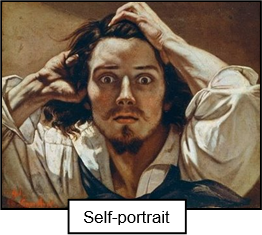 xxxxxThe French painter Gustave Courbet was the leader of the Realist movement. He maintained that the task of the artist was to “record the manners, ideas and aspects” of the age in which he lived. For him, painting was essentially a “concrete art” which could only depict “real and existing things”. As a result, many of his works portrayed contemporary peasant life with uncompromising frankness, and some of his portraits and nude figures were purposefully given unattractive features in order to emphasize this acceptance of the “un-
xxxxxThe French painter Gustave Courbet was the leader of the Realist movement. He maintained that the task of the artist was to “record the manners, ideas and aspects” of the age in which he lived. For him, painting was essentially a “concrete art” which could only depict “real and existing things”. As a result, many of his works portrayed contemporary peasant life with uncompromising frankness, and some of his portraits and nude figures were purposefully given unattractive features in order to emphasize this acceptance of the “un-
xxxxxCourbet was born in Ornans, a small town in the mountainous Jura region of eastern France, close to the Swiss border. As a child he fell in love with the outstanding beauty of this area, and scenes from the local countryside later featured in many of his landscapes. After starting art lessons at the age of 14, in 1837 he moved to the nearby town of Besancon to study law (as his parents believed), but instead attended the local art academy for two years before making his way to Paris. Full of self-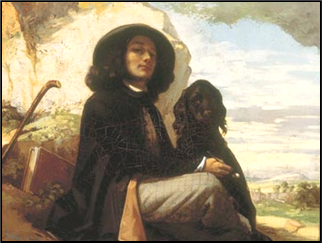 a touch of arrogance, he furthered his artistic skills by copying paintings in the Louvre -
a touch of arrogance, he furthered his artistic skills by copying paintings in the Louvre -
xxxxxIn fact, a change in fortune came about in 1848, the year of revolution. Courbet -
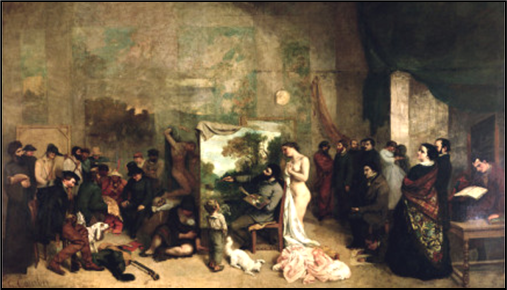 xxxxxHowever, when exhibited at the Paris Salon of 1850 it was viewed with some alarm. It was seen by many as “vulgar” -
xxxxxHowever, when exhibited at the Paris Salon of 1850 it was viewed with some alarm. It was seen by many as “vulgar” -
xxxxxThis public protest brought him both fame and notoriety, and encouraged him to spread his gospel further afield. Over the next fifteen years he traveled widely, and was well received wherever he went. He met the American artist James Whistler and the young Claude Monet during his travels in France, and he exhibited his works in Germany, Holland, Belgium and England. Such was the standing that he achieved, that in 1870 the French government offered him the Legion of Honour. Courbet declined the decoration, seeing it as state interference in the world of art, and the following year, with the coming of the Paris Commune, he was again at odds with the authorities. Once the insurrection had been put down, he was accused of conspiracy in the destruction of the Vendôme Column in Paris, a monument to Napoleon Bonaparte’s victories. It would seem that he was not in fact involved in this event, but, given his republican sympathies, he was made the scapegoat. He was imprisoned for six months and given such a heavy fine that, once released from prison, he escaped and spent the rest of his life in Switzerland. He hoped for a reprieve but it never came.
xxxxxAs an artist Courbet painted rapidly, using a limited palette and showing a remarkable technical skill at depicting textured surfaces. In his landscape and marine paintings he often used thick layers of paint, quickly but skillfully applied by means of a wedged-
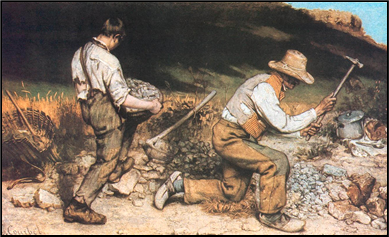 xxxxxOutstanding among his realistic peasant settings were his Stone Breakers of 1849, a powerful work depicting menial labour (destroyed in the Second World War), The Sleeping Spinner of 1853, and The Winnowers of 1855, showing peasant women at work. Many of his landscapes were inspired by the rugged terrain of his native Franche-
xxxxxOutstanding among his realistic peasant settings were his Stone Breakers of 1849, a powerful work depicting menial labour (destroyed in the Second World War), The Sleeping Spinner of 1853, and The Winnowers of 1855, showing peasant women at work. Many of his landscapes were inspired by the rugged terrain of his native Franche-
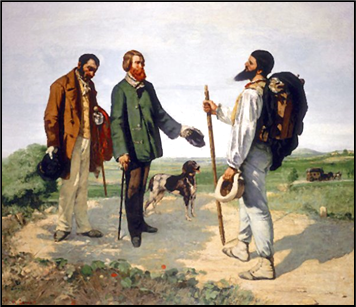
xxxxxAmong his best still-
Va-
xxxxxIncidentally, Courbet’s outgoing personality, and his strict interpretation of the artist’s role in society, won him a num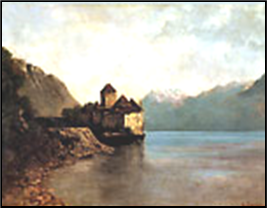 ber of intellectual friends, including the poet Charles Baudelaire and the political theorist Pierre Proudhon. The Brasserie Andler, the café where they to used to meet in the late 1840s to discuss art and literature, came to be known as “The Temple of Realism”. ……
ber of intellectual friends, including the poet Charles Baudelaire and the political theorist Pierre Proudhon. The Brasserie Andler, the café where they to used to meet in the late 1840s to discuss art and literature, came to be known as “The Temple of Realism”. ……
xxxxx…… During the last four years of his life, spent in Switzerland, Courbet made a living painting portraits and landscapes. Among the latter were numerous versions of the Château de Chillon, situated on Lake Geneva, near Montreux.



